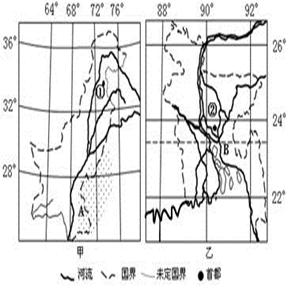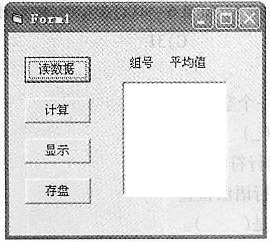甲、乙两国历史渊源悠久,阅读下图并结合所学知识回答问题(19分)

(1)简析甲国A地区沙漠广布成因 (3分)
(2)①、②两城市分别为甲、乙两国的首都,对比分析其不同的区位条件。 (6分)
(3)乙国B平原水灾频繁。从地形、气候、水文等多方面分析当地洪涝灾害频繁的原因(4分)
(4)对比分析流经城市②的河流与锡尔河的水文特征的差异(6分)
(1)位于南亚内陆地区,西南季风难以到达,故干燥少雨(1分)。另外,历史上原始森林遭到破坏,也加重干燥程度(1分);冬季受副高控制(1分)
(2)①城市位于高原地区(1分),气候凉爽,交通便利(2分);②城市位于河口三角洲(1分),靠近河流,交通便利,地势平坦,雨热同期(2分)等。
(3)位于西南季风的上风地带,降水较多;(1分)地势低平;(1分)多条大江大河交汇下流地带,河流汛期集中夏季,径流量大(2分)等。
(4)恒河(或布拉马普特拉河)流量大;有汛期,汛期出现在6~9月;河流的补给形式以雨水补给与冰川融水为主;无结冰期;锡尔河:流量小;有汛期,汛期出现在7~8月;河流的补给形式以冰川融水为主;有结冰期。(一条河流3分,侧重具有差异的方面)
题目分析:(1)根据图示的经纬度位置和海陆轮廓判断,甲国A地区的沙漠为塔尔沙漠,且成因主要从受西南季风影响小,副高影响和历史时期的植被破坏等方面分析。(2)结合图示信息,可从地理位置、气候、地形、河流和交通等因素分析影响城市的区位条件,注意比较分析。(3)图示乙国的B平原,地势平坦,排水不畅;从气候条件分析,该地区受热带季风气候影响,夏季多暴雨;从水文环境分析,该地区河网纵横,多条河流交汇,且位于孟加拉湾的顶部,夏季受风暴潮和天文大潮的顶托作用。(4)河流水文特征可从河流的流量、流量的季节变化、冰期、含沙量、流速和水能资源等方面分析,注意流经城市②的是恒河,受热岛季风气候影响,且该地区地势平坦;而锡尔河位于中亚,受温带大陆性气候影响。注意比较两者水文条件的差异。
点评:本题难度一般,能根据图示的 经纬度位置和海陆轮廓准确的判断地理位置是解题的关键。并结合区域的地理环境掌握影响城市区位、洪涝灾害和河流水文特征的一般分析思维,注意答题的完整性。

